Choosing out the right display and screens for your Raspberry Pi projects can make all the difference. But, with the contrasting types and sizes for resistive touch displays, TFT displays, HDMI displays, e-ink displays, and displays with cool RGB matrices, many find it challenging to choose the best monitor for their Raspberry Pi.
Need to own or create a small computer of your own? If so, all you need is a Raspberry Pi board, a display unit, and an optional keyboard. However, all the above does not matter if you don’t have the perfect touch screen/display unit that you can use to create a more fabulous DIY computer of your own.
The 10 best touch-screens for Raspberry Pi
In this article, we will list all of the best and most compatible screens at your disposal. We have selected these screens based on the following factors:
1. Price
The very first factor in the purchasing guide list is the price. The price of the monitors tends to be more expensive depending on several features like resolution, size, and many more. When purchasing, ensure you check whether the device is within your budget or not. So here, you will read the product info well to know which product best suits your requirements.
2. Screen size and resolution
Ever heard of the rule of thumb? The larger, the better. The best of the Raspberry Pi screens we got here are 1080P high resolution and are full-touch screens. This, though, is a standard benchmark despite the higher available variants.
3. Brightness (B) and Contrast (CR)
Brightness in this aspect refers to the quality of reflecting light or perception by laminating a visual target. It is expressed by the consideration of power consumed by a specific area of the monitor. Most, if not all, of the displays, have 200cd/sq.m, which is sufficient for normal usage.
The contrast ratio (CR) refers to the ratio luminance of the brightest to the darkest color. Generally, screens can give a high contrast ratio as per the desired. Note that there are no specific standards to measure the contrast ratio.
4. Display resolution
This refers to the count of distinct pixels in each breadth that can be displayed. It is controlled by several factors, such as flat-panel displays, LCDs, and CRT. If the resolution you opt for is not compatible, the monitors will stretch and shrink to fit in the specified resolution. This, in turn, results in a great loss of the signal and quality distortion.
5. Connectivity
Since regular displays make effective communication between peripherals, we suggest you use connectors such as HDMI, VGA & AV-input. Below is a breakdown of the listed connectors
HDMI- High Definition Multimedia Interface
HDMI port is an audio-video crossing point for transmitting uncompressed to compressed data from an HDMI source device.
VGA- Video Graphics Array
This is a 3-row connector provided on many display devices such as computers, TVs, laptops, and projectors. It is a decent quality cable that supports the signal within the bandwidth range of (2MHZ-500MHz).
AV-Audio Visuals Port
This is just a connector to receive audio/video signals from electronic equipment. It mostly cooperates with TVs and DVD recorders and is very convenient for connecting headphones or speakers.
All three connectors play a vital role in making the Raspberry Pi displays more reliable and accurate.
6. Compatibility
You need to look for a screen’s compatibility standards with the various systems you may use besides the Raspberry Pi.
Without further ado, let us jump straight into the 10-best Raspberry Pi touch screens.
1. Raspberry Pi 7” Touch Screen Display
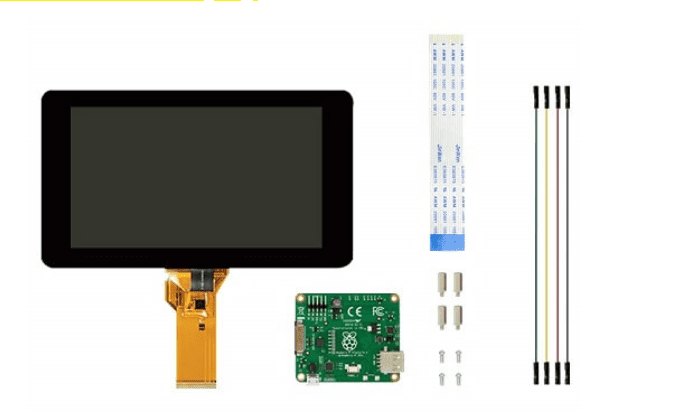
Raspberry Pi 7 touch monitor
The first on our list is an LCD touch screen straight from the official foundation of Raspberry Pi. The monitor is 7 inches large, with a touch display created explicitly for the Raspberry Pi board. With it comes 800×480 multi-touch support resolution. In addition, there are only two connections needed to make from the display to the Raspberry Pi board, thus easing the installation process.
It also includes an adapter board that takes care of power in a surge, signal conversion, or touch input. The adapter also doubles as a mounting bracket with four standoffs to attach the Raspberry Pi for stability. It is a relatively compact and a very nice setup that should suit tablet-style and embedded projects, despite not being inclusive of a stand or case.
The monitor provides a very amicable color and top-notch touch responsiveness. Nevertheless, the brightness suffers in places with ample light, for instance, outdoors.
Pros:
- A highly trusted screen is suggested for Raspberry Pi boards as it comes from the Raspberry Pi company.
- Great quality
Cons:
- Despite being compatible with all the existing Raspberry Pi models, the hole line up for the installation is only good enough for Raspberry A+, Raspberry B+, Raspberry Pi 2
2. Raspberry Pi 10” Touch Screen
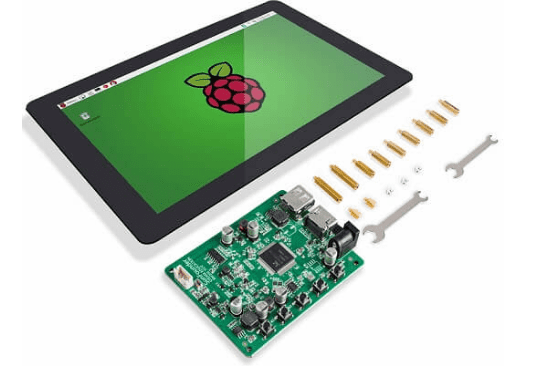
Raspberry pi 10″ touchscreen monitor
The Raspberry Pi 10.1 inch Display comes with a decent resolution of 1280×800 pixels. The display unit can support both the 3rd and 2nd models series without encountering any incompatibility issues. Besides that, the Pi board works just fine on Android, Windows, iOS, and other software. Not to mention, Ubuntu users can use this machine peacefully, which is an aspect you can barely come across nowadays.
The display kit can be used on 4 standoffs made from durable stuff such as copper. During the connection stage, ensure you join the display and the controller using the HDMI cable.
Below are some of the benefits and setbacks of the Raspberry Pi 10 inch Touch Screen that received its spot in our list of the best touch screen monitors for Raspberry pi to get in 2021.
Pros:
- The manual is straightforward.
- It comes with high performance.
- The touch screen can sense 10 fingers.
- It is suitable for working with a wide range of users.
Cons:
- It does not work during low voltage.
- The display kit does not come with speakers.
3. Kuman 5-inch Resistive Touch HDMI LCD
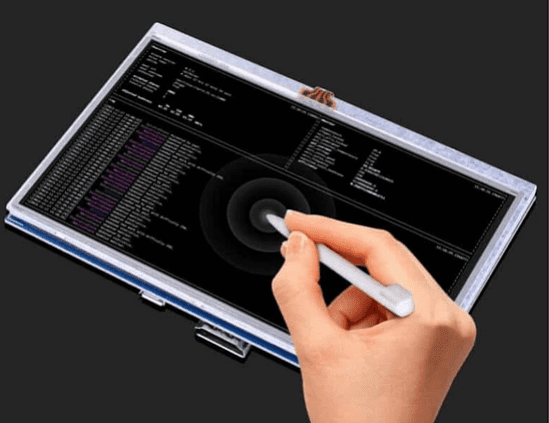
Kuman 5 touch monitor
The Kuman 5” resistive touch screen has a resolution of 800×480 Pixels. The monitor is made of quality and durable equipment, hence the decency. The 5” monitor can be used with several Raspberry Pi equipment (better at compatibility). Nevertheless, you cannot use it with the zero Pi board.
With it comes a display kit containing excellent anti-jamming capabilities, along with a magnificent view. The interface is a 16-bit parallel coming with a display panel alongside the 800×480 pixels of resolution.
The screen comes with a touchpad, flash print, and an SD card slot. These are features that should be verified upon purchasing as they come along with the screen.
The monitor is accompanied by a manual containing all the directions of use and safety measures subjected to the screen. Note that the kit is packed in a cardboard box.
Consideration when making projects on the Raspberry Pi:
- 800x480P.
- 5” HDMI LCD.
- HDI adapter.
- Power supply.
- Controller (SSD1963).
- Screws pack.
- Touch Pen.
- USB plug cable.
- Blue color PCB.
- 8-16 bit parallel bus interface.
Pros:
- It works excellent on both Linux and Windows OS.
- It is affordable.
- It comes with a source code that enables the item to work efficiently.
Cons:
- It does not ship with a camera.
- It cannot be used with Raspberry Pi zero board.
4. OSOYOO 3.5” HDMI Touch Screen LCD monitor
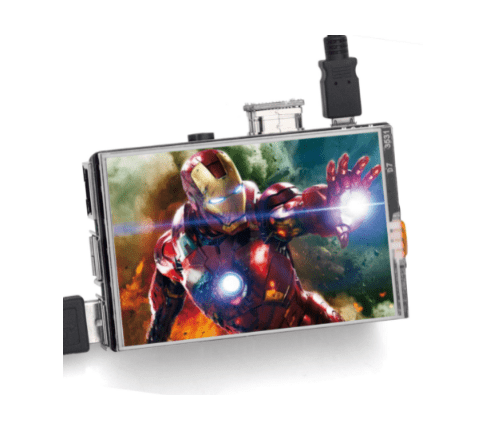
OSOYOO Raspberry pi Monitor
Are you looking for a responsive and portable screen for the Raspberry Pi embedded project? If yes, OSOYOO 3.5” is the best shot for you. The monitor is compatible with many systems, such as KOOKYE customized OS Raspbian, Kali, Ubuntu, and Offical.
The 3.5” inch screen with an HDMI display can showcase very high-quality pictures because of the adjustable resolution between (480×320) to (1920×1080) with a recommendation of 3:2. In this course, we recommend going with (720×480 and 810×540). To add on, the monitor only works when mounted directly on GPIO pins on the Raspberry Pi board.
It has a refresh rate of 60 frames per second, supporting games and video playing without lagging.
Pros:
- High-resolution images firm (480×320) up to (1920×1080) pixel resolution allow you to enjoy video playbacks/games.
- It can be installed directly on your Pi device via the GPIO pins.
- It can operate with your Pi without external power.
- Easy to install.
- Lightweight, hence the portability.
- Comfortable operations.
- Supports the best several operating systems, including Raspberry, Windows 10, and a lot more.
Cons:
- The monitor only works when mounted directly on GPIO pins
5. ELECROW 5” Raspberry Pi Touchscreen Display
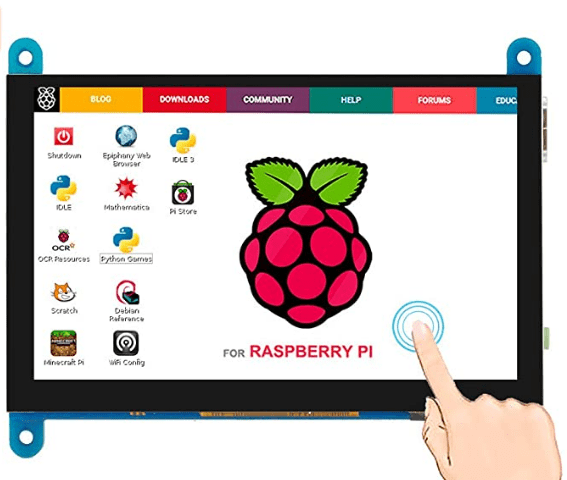
elecrow 5 monitor
The Elecrow 5” Raspberry Pi Touchscreen Display isn’t the most impressive or expensive Raspberry Pi touch screen out there, but that is why we like it so much. The monitor does not compromise its excellent quality display despite its affordability. When talking about the specifications, the Elecrow 5” Raspberry Pi touchscreen monitor features a 5 inch TFT LCD resistive touchscreen panel (inclusive of the touch pen). The monitor can also display up to a maximum resolution of 800×480 with a smooth refresh rate of 60Hz.
It interfaces with the Raspberry Pi through HDMI with a nifty little micro-adapter which plugs into the port and the Pi simultaneously without too much cabling. The monitor maintains a stable standoff through the two mounting mechanisms, allowing the Pi to sit behind the screen with minimal setup.
It has a range of compatibility nature that supports the Pi Model B+, Pi 2 Model B, Pi 3 Model B, and Model B+. Additionally, the 5V low power consumption rate is another highlight. With this feature, the monitor sources power from the GPIO pins on the Pi or micro-USB port with any standard Pi power supply.
The monitor is suitable for Raspberry Pi tinkerers who want to try their hand designing and 3D printing. Unfortunately, it has the aesthetics to match, rough around the edges with an exposed finish that may not suit those who prefer a more stylish look for their screen.
Pros:
- It has a 60 Hz refresh rate.
- It has a low power consumption.
- It has Rpi back mounting.
- It has an 800×480 resolution.
- It has a 5 inch TFT LCD screen.
Cons:
- Does not have the most aesthetic finish.
6. Miuzei Raspberry Pi Touchscreen with Case and Fan
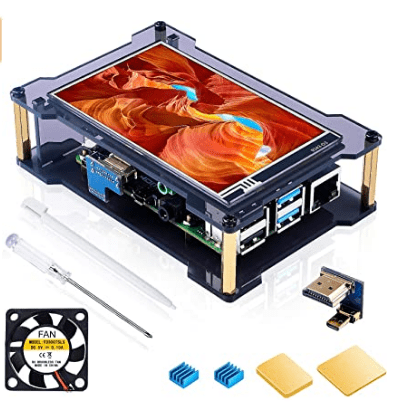
miuzei raspberry pi monitor
Rather than just providing a screen, the Miuzei Raspberry Pi 4 touchscreen ships the monitor with a case and a fan, which is advantageous to the user. First things first, the screen boasts a 4 inch IPS touchscreen LCD capable of pushing up to a maximum resolution of 800×480 pixels and a refresh rate of 60HZ. The monitor has a very outstanding color accuracy and a sharp image display.
It connects to the Raspberry Pi via an included HDMI mini-adapter that sits inconspicuously within the dimensions of the case. It also features four integrated ports: micro USB, audio, HDMI, and a button to adjust brightness and toggle the backlight on and off.
To add on, it has a 30mm fan that acts as a coolant to keep both the Pi board and the screen cool when performing heavy functionalities. As such, it sandwiches the Raspberry Pi between two acrylic layers held together by four large standoffs.
The monitor sits on the top layer as the bottom layer acts as the protector for the underside of the Pi module. This, therefore, means that the screen can be powered via the Pi’s GPIO or power supply linked to the USB port on the backplate.
Note: It’s a precautionary measure to be aware that the Miuzei Raspberry Pi 4 touchscreen with a case and a fan is only compatible with the Raspberry Pi 4, hence not supporting any of the older versions.
Pros:
- It has a 60 Hz refresh rate.
- It has a 4-inch IPS touchscreen and stylus.
- It has an 800×480 resolution.
- It has integrated audio, HDMI, and USB ports.
- It has a case design with fans and heat sinks.
Cons:
- Limited GPIO access.
- It is only compatible with Pi model 4.
7. ASUS ZenScreen Monitor Display
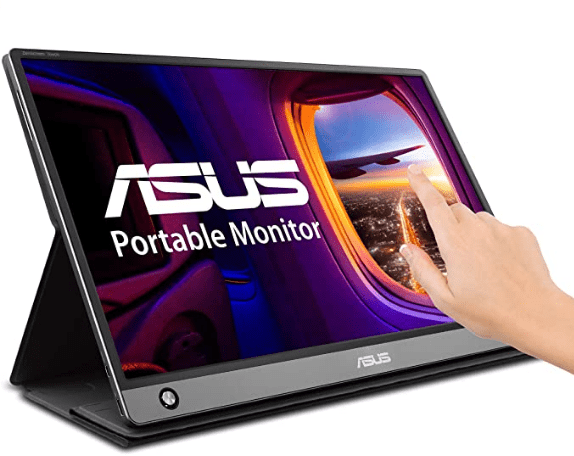
Asus ZenScreen monitor
The ASUS ZenScreen is a very great-looking screen designed for its portability. This feature aids users with media stations and mobile Pi projects to easily maneuver around with them. The monitor features a 15.5 inch IPS display with 1920×1080 pixels of resolution. Additionally, it comes with in-built speakers and a robust 7800 mAh battery.
The display is a touch sensation that allows intuitive 10-point fingertip control and gestures alongside excellent accuracy and responsiveness. It has a classic weight of 2lbs and measures not more than 0.3 inches in width, making it an ultra-portable option despite the large screen size.
The monitor ships with a foldable smart case that doubles as a multi-position stand and a holder for the included smartpen. For the interface functionality with the Raspberry Pi, the screen uses two options (HDMI or USB Type-A, Type-C).
The monitor lacks the integrated mounting mechanism since the ASUS ZenScreen is not mainly designed for Raspberry Pi. As such, expect to have your Pi sitting alongside the screen when in use. However, this does not really matter since the portability, conspicuous image quality, touchscreen controls, and Raspberry Pi compatibility features baked into the screen should be the major highlights.
Pros:
- It is lightweight and portable.
- It has a 7800 mAh battery.
- It has built-in speakers.
- It has 1920×1080 resolution.
- It has a 15.5 inch IPS touchscreen display.
- Comes with a smart cover and smartpen.
Cons:
- No Raspberry Pi mounting.
- It is expensive.
8. UCTRONICS 5” Touch Screen for Raspberry Pi 4

uctronics 5″ monitor
This is a 5-inch touchscreen for Raspberry Pi 4 models. It is a portable and capacitive HDMI LCD touchscreen monitor for Pi 4B, 3B+, windows 10,8, and 7. It has an 800x480P standard resolution that can scale up to 1920×1080 Pixels input using auto-scaling features. Additionally, it has a 158o wide viewing angle and an adjustable backlight that enhances a high visual quality. With it comes an audio/headphone jack, micro HDMI adapter, hassle-free connection, capacitive multi-touch, and higher touchscreen sensitivity.
The monitor also has 5 points multi-touch capability that requires OS and software support. This makes it compatible with Raspberry Pi 4B, 3B+, 3B, and all other Model A&B series. It can work as a general-purpose compact touchscreen monitor as it can connect to almost any device with an HDMI input and touch control through the USB connection.
Note: you don’t need any installer drivers to connect to the monitor.
Pros:
- It has 5 point multi-touch capability.
- Compatible with Raspberry Pi 4B, 3B, 3B+ and all other Model A&B series.
- Works as a general-purpose compact touchscreen monitor with USB enabled touch controller.
- It has 800×480 physical resolution, scaled up to 1920x1080P input through auto-scaling.
- It has a mode switch button for backlight ON/OFF audio split output from HDMI.
Cons:
- None too specific.
9. Kuman 7” Capacitive Touch Monitor
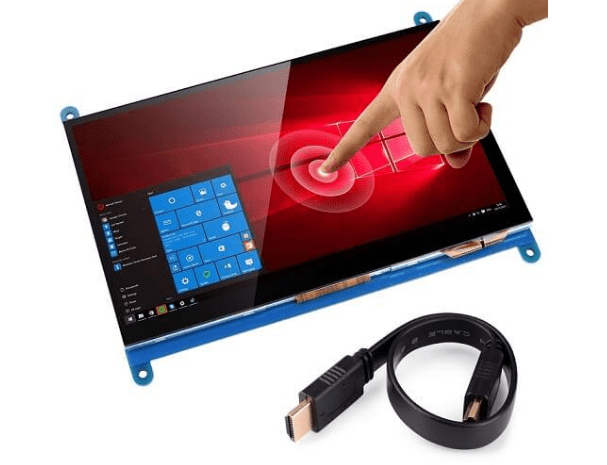
Kuman 7 inch touch monitor
Next on our list is a monitor by Kuman, one of the top manufacturers in hobby electronics. The monitor is a 7-inch large TFT capacitive touch screen. It supports a 1024×600 screen resolution and a capacitive control with 4:3 and 16:0 display conversion.
The monitor has horizontal and vertical image flip functionality that supports 864x480x24-bit graphics content using the SSD1963 controller. Kuman 7 inch has an onboard 400mAh DC to DC boost regulator for a steady LCD backlight power supply with a 24-bit pixel color depth.
About connectivity, the monitor has a dual-port for equipping MCU interfaces in different buses. Additionally, it can support BB black, Angstrom, Banana Pi, and Banana Pro.
Some of the constituents included in the kit are:
- USB OTG cable.
- The LCD screen.
- Source code and install drivers.
- Instructional manual.
Pros:
- It is affordable compared to the official LCD board for Raspberry Pi.
- It has universal malleability as it is compatible with many boards like Banana Pi, Banana Pro, Angstrom, and BB Black.
Cons:
- None too specific to review.
10. WIMAXIT 8 Inch HDMI Display Screen for Raspberry Pi 3

WIMAXIT 8 -inch monitor
This is an 8 inch large IPS touch screen with 1280×800 screen resolution made for DIY Raspberry Pi kits. WIMAXIT is probably the only monitor enlisted here that comes with a substantial if not the only company with a warranty on the list. Additionally, the monitor comes with two stands to offer screen stability.
Some of the screen specifications include:
- HDMI, USB, and VGA support.
- Built-in earphone jack.
- 400 Nits of brightness level with 800:1 contrast.
- A wide view angle of 89/89 for both U/V and V/H.
- 8-inch screen size with 1280×800 native resolution.
Pros:
- It is easy to use
- It has a simple DIY build
- It comes with 1 year of manufacturer’s warranty initiated from the day of purchase.
Cons:
- It has light bleeding issues
Conclusion
The article has comprehensively covered a great deal of the 10 best Raspberry Pi touch screens together with their advantages and disadvantages. We also looked at the factors that led to the selection of these monitors, including the price, compatibility issues, connectivity, screen size, resolution, brightness and contrast, and display resolutions that you should be well versed with. To this far, we hope you found this article helpful; thanks for reading! And feel free to reach out through the comment section in case of anything.
1 comment
I bought a ZenScreen after seeing this article on the web. It’s a really nice looking monitor and I love it – but it seems like it won’t work with the Raspberry Pi Zero 2 W and I’m not clear on how it would be used with a standard Pi.